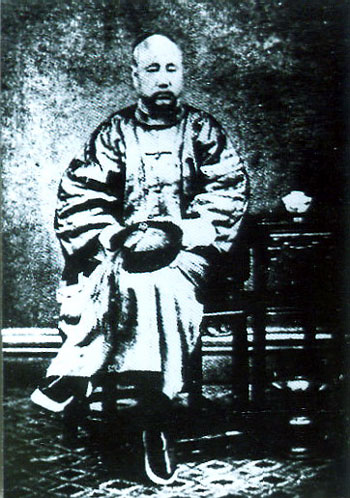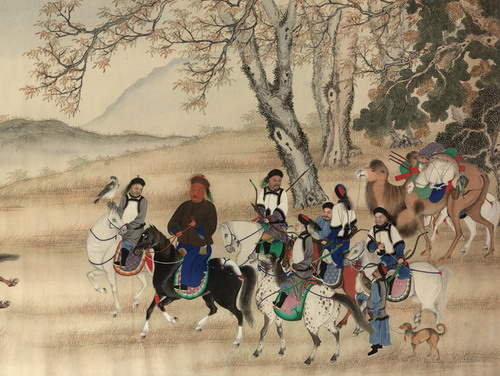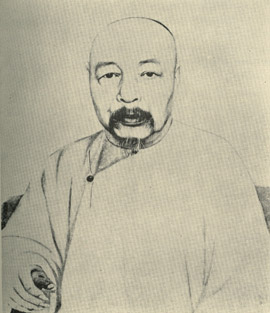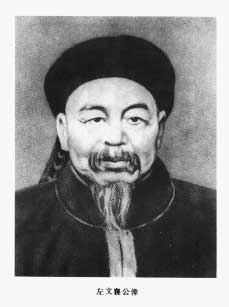<Back to Index>
- General of the Qing Sengge Rinchen, 1811
- Official and General of the Qing Guanwen, 1798
- Official and General of the Qing Zuo Zongtang, 1812
PAGE SPONSOR


Sengge Rinchen (Chinese: 僧格林沁; Tibetan: སེང་གེ་རིན་ཆེན།; Mongolian: ᠰᠡᠩᠭᠡ ᠷᠢᠨᠼᠡᠨ, 1811 – May 19, 1865) was a Mongol nobleman and general during the Qing dynasty, who is mainly known for his role during the Second Opium War and the suppression of the Taiping and Nian rebellions.
Sengge Rinchen came from the Horchin Left Rear Banner in Inner Mongolia and belonged to the Borjigin clan, which could trace its origins back to Genghis Khan's brother Hasar. His personal name consists of the Tibetan words for "lion" and "treasure" respectively. In 1825, he became an imperial prince of the second degree (郡王).
Sengge Rinchen is mainly known for his role in a number of military campaigns in the mid nineteenth century. In 1853, Sengge Rinchen stopped the northern expedition of Taiping army and captured one of its leaders, Li Kaifang. In 1855, Sengge Rinchen's status was elevated to Prince of the First Degree in recognition of this.
Four years later during the Second Opium War, he was
appointed imperial commissioner in charge of leading the
campaign against the British and French invasion. In 1859, he
defeated the British and French forces at the Taku Forts.
However, only one year later he slipped away to Peking
with 150 cavalrymen, leaving his garrison at Taku Forts to
fend for themselves against a second, larger force
composed of 11,000 British and 7,000 French. When only one
of the Taku Forts resisted, while the rest surrendered
without a fight, Sengge fell back to defend Peking with
30,000 "invincible" Manchu cavalry combined with an
entrenched garrison of 20,000 Chinese army. The Manchu
cavalry was shy 28,000 men from its reputed strength,
while his garrison ran away in face of artillery fire.
Once Peking fell, Senge was subsequently transferred to
fight against the Nian rebellions, which he fought
successfully and earned him back all his former titles and
ranks. In 1865, during a campaign against the Nian
Shandong, Sengge Richen was ambushed by a group of Nian
rebels and killed. The Nian
rebellion was finally suppressed in 1868.
Following his death, the imperial court canonized Sengge Rinchen in recognition of his service to the Qing dynasty and made his rank as imperial prince hereditary under the name of the "loyal prince" (忠親王). In 1889, Empress Dowager Cixi ordered that a shrine be erected in his memory under the name Xianzhongci (顯忠祠), which still stands in the Dongcheng District in Beijing.
In official history works in the People's Republic of
China's, Sengge Rinchen's Qing loyalist stance is
interpreted as an expression of his Chinese patriotism,
and in 1995, the local government of Tongliao in Inner
Mongolia opened a Sengge Rinchen memorial museum.
Guanwen (Chinese: 官文; clan name Wangjia 王佳, Styled Xiufeng; created Count Yiyong of the first Class, no deputy Order of succession 勇毅一等伯 世襲罔替) (1798 – 1871) was an eminent Manchu official, Grand Secretary, military general, Viceroy of Zhili, Huguan and commander of the Army Group Central Plain the late Qing Dynasty in China. He raised the Green Standard Army to fight effectively against the Taiping Rebellion and restored the stability of Qing Dynasty along with other prominent figures, including Zuo Zongtang and Li Hongzhang, setting the scene for the era later known as the “Tongzhi Restoration” (同治中兴). He was known for his strategic perception and administrative skill.
Guanwen was appointed Viceroy of Huguang from 1856 when the civil war had been fought. There were two Viceroys of Huguang killed in battle and one who had committed suicide before him. Guanwen led a 600,000 strong Green Standard Army in the Central Plain that oversaw the Xiang Army and resisted the Taiping Rebellion successfully. His army was stationed in northern Hubei. He followed an excellent strategy for Qing and increased Zeng Guofan’s deep dislike of Guanwen.


Zuo Zongtang (Chinese: 左 宗棠; Courtesy name: Chinese: 季高; pinyin: Jěgāo) (November 10, 1812 - September 5, 1885), spelled Tso Tsung-t'ang in Wade-Giles and known simply as General Tso in the West, was a Chinese statesman and military leader in the late Qing Dynasty.
He was born in Wenjialong, north of Changsha in Hunan
province. He served in China's northwestern regions,
quelling the Dungan revolt and various other disturbances.
He served with distinction during the Qing Empire's civil
war against the Taiping Rebellion, in which it is
estimated 20 million people died.
Zuo Zongtang was born on November 10, 1812, into a poor family in Xiangyin County, Hunan.
Zuo's career got an inauspicious start when, as a young
man, he failed the official court exams seven times
(ca. 1822 - 1835). He decided to abandon his plans to
become a civil servant and returned to his home by the
Xiang River in Hunan to farm silkworms,
read and drink tea. It was during this period that he
first directed his attention to the study of Western
sciences and political economy.
When the Taiping Rebellion broke out in 1850, Zuo, then 38 years old, was hired as an advisor to Zeng Guofan, the governor of Hunan. In 1856, he was formally offered a position in the provincial government of Hunan. In 1860, Zuo was given command of a force of 5,000 volunteers, the Xiang Army (later known as "Chu Army"), and by September of that year, he drove the Taiping rebels out of Hunan and Guangxi provinces, into coastal Zhejiang. Zuo captured the city of Shaoxing and, from there, pushed south into Fujian and Guangdong provinces, where the revolt had first begun. In 1863, Zuo was appointed Governor of Zhejiang and an Undersecretary of War.
In August 1864, Zuo, together with Zeng Guofan, dethroned the Taiping teenage king, Hong Tianguifu, and brought an end to the rebellion. He was created Earl Kejing of the 1st Class for his part in suppressing the rebellion. He, Zeng Guofan and Li Hongzhang were called Zeng, Zuo, Li, the leaders in suppressing the rebellion.
In 1865, Zuo was appointed Viceroy
and Governor General of Fujian and Zhejiang. As
Commissioner of Naval Industries, Zuo founded China's
first modern shipyard and naval academy in Fuzhou the
following year.
Zuo's successes would continue. In 1867, he became Viceroy and Governor General of Shaanxi and Gansu and Imperial Commissioner of the Army in Shaanxi. In 1884, his fellow Hunanese Xiang army officer, Liu Jintang (Liu Chin-t'ang), was appointed as the first Governor of Xinjiang province. The Governor of Xinjiang was the subordinate to the Governor General of Shaanxi and Gansu.
In these capacities, he succeeded in putting down another uprising, the Nian Rebellion (捻軍起義), in 1868.
After this military success, he marched west with his army of 120,000 people, winning many victories with advanced Western weapons in the Dungan revolt of Northwestern China, including today's Shaanxi, Ningxia, Gansu and Qinghai provinces and Xinjiang, in the 1870s.
Several Muslim generals, such as Ma Zhan'ao, Ma Anliang, Ma Qianling, Dong Fuxiang, and Ma Haiyan from Hezhou, who had defected to General Zuo's army, helped him crush the "Muslim rebels". General Zuo rewarded them by relocating the Han Chinese from the suburbs of Hezhou to another place and allowing their troops to stay in the Hezhou suburbs as long as they did not live in the city itself.
In 1878, he successfully suppressed the Yakub Beg's uprising and helped to negotiate an end to Russian occupation of the border city of Ili. He was vocal in the debate at the Qing Imperial court over what to do with the Xinjiang situation, advocating for Xinjiang to become a province, in opposition to Li Hongzhang, who wanted to abandon what he called "Useless Xinjiang" and concentrate on defending China's coastal areas. Zuo won the debate, Xinjiang was made a province, and many administrative functions were staffed by his Hunan officers.
Zuo was outspoken in calling for war against Russia, hoping to settle the matter by attacking Russian forces in Xinjiang with his Xiang army. In 1878, when tension increased in Xinjiang, Zuo massed Chinese troops toward the Russian occupied Kuldja. A Canadian spectator stated in 1878, "News from Turkestan says the Chinese are concentrating against Kuldja, a post in Kashgar occupied by the Russians.... It is reported that a Russian expedition from Yart Vernaic has been fired upon by Chinese troops and forced to return." The Russians were afraid of the Chinese forces, thousands of whom were armed with modern weapons and trained by European officers, because the Russian forces near the Chinese border were undermanned and under - equipped, so they agreed to negotiate.
Zuo's Xiang Army troops were armed with modern German Dreyse needle rifles and Krupp artillery.
For all his contributions to his nation and monarch, Zuo was appointed a Grand Secretary to the Grand Secretariat in 1874 and elevated to Marquis in 1878.
Zuo was appointed to the Grand Council, the cabinet of the Qing Empire at the time, in 1880. Uneasy with bureaucratic politics, Zuo asked to be relieved of his duties and was appointed Viceroy of Liangjiang in 1881. In 1884, upon the outbreak of the Sino - French War, Zuo received his fourth and last commission as commander - in - chief and Imperial Commissioner of the Army and Inspector General overseeing coastal defense in Fujian. He died shortly after a truce was signed between the two nations, in Fuzhou in 1885.
Zuo Zongtang was admired by many generals who came after
him. The Muslim General Bai Chongxi wanted to reconquer
Xinjiang for the Kuomintang central government, in Zuo
Zongtang's style, and expelled Russian influence from the
area.
Zuo Zongtang was also referred to by Muslim General Ma
Zhongying (a descendant of a Salar noble) as one of his
models, as Ma led the KMT 36th Division (National
Revolutionary Army) to reconquer Xinjiang for the
Kuomintang from the pro-Soviet governor Jin Shuren during
the Kumul Rebellion.
General Tso's chicken was introduced in New York in the 1970s and is named in honor of the historic figure.